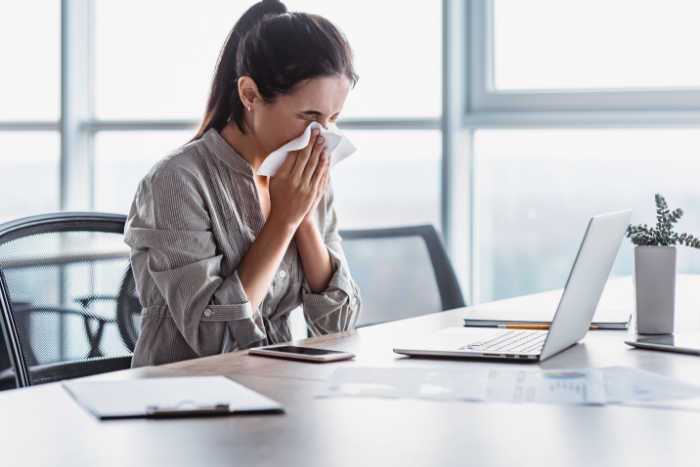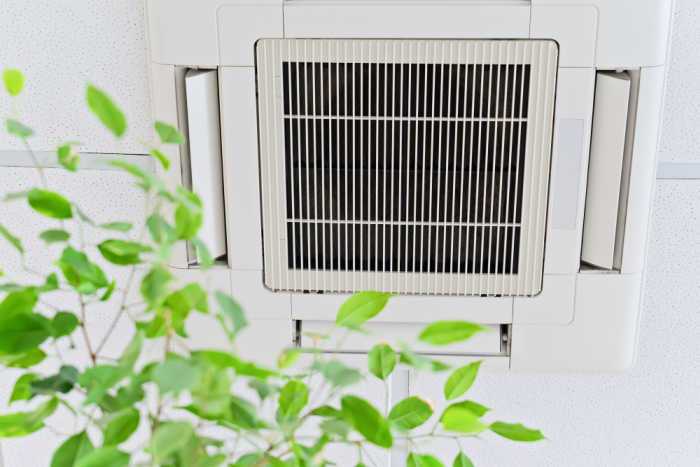As a business owner there are many reasons to focus on indoor air quality. Ensuring a constant supply of fresh, clean air boosts employee health and wellbeing and increases productivity. It can also lower costs associated with staff sickness, building maintenance and energy use.
Yet despite the considerable benefits, it’s really only the events of the past few years that have made workplace air quality a priority.
In this post we look at what we mean by indoor air quality, the pollutants that affect it, and how to improve it for the benefit of both your business and the people employed within it.
Indoor air quality (IAQ) refers to the overall quality of ambient air circulating in and around a building. There are many factors that impact IAQ, like temperature, humidity, ventilation and air pollutants.
It matters because poor IAQ can have various consequences. In a workplace setting these include:

Worsening health conditions - employees with allergies and respiratory conditions like asthma are particularly prone to the effects of low IAQ, and time spent within a poor quality air environment can worsen symptoms.
Sick building syndrome - a condition affecting otherwise healthy employees that is attributed to time spent inside a building. Symptoms include headaches, a runny nose, coughing, dry eyes, sore throat and itchy skin.
Lower productivity - poor IAQ is known to affect concentration and in some cases can induce tiredness and fatigue. This in turn impacts workplace productivity.
Building damage - as well as the people in it, poor IAQ can also affect the fabric of a building, with common issues including damp and mould.
At the extreme end of the scale, prolonged exposure to particularly poor IAQ can lead to diseases affecting everything from the lungs to the brain.
A building’s IAQ is affected by the air drawn in from the outside environment - either through natural or mechanical ventilation as well as structural gaps - and air pollutants created inside the building.
These indoor air pollutants include:
Particulate matter - solid or liquid particles present in the air like dust, mould spores and bacteria.
Carbon dioxide - a product of breathing, carbon dioxide is a naturally present gas that can build up in poorly ventilated spaces.
Volatile organic compounds (VOCs) - these are indoor air pollutants produced by things like cleaning supplies, paints, printers, photocopiers, carpets and furniture.
Excess humidity - this typically results from poorly regulated temperature and a lack of ventilation, causing damp and condensation.
Mould - excess humidity can also lead to mould, as can an accumulation of dirt. Mould itself is an indoor air pollutant that can significantly impact allergies and respiratory conditions.
To improve indoor air quality in the workplace, consider adopting the following practices as part of your wider building maintenance process.
Achieving an ideal temperature isn’t just about providing comfort. It also impacts humidity which, as we’ve seen, is a source of indoor air pollution. Yet because of changes in room occupancy and the weather, temperature can be highly volatile.
A well designed air conditioning system that is properly controlled and maintained can meet this challenge, helping to regulate temperature (and humidity) regardless of influencing conditions.

Good ventilation is key to improving indoor air quality. This means intentionally introducing outdoor air to dilute and displace indoor pollutants.
In some cases natural ventilation, like open windows, may suffice. In others, you might look to invest in mechanical ventilation with heat recovery (MVHR). These systems are an effective way to introduce a constant stream of fresh, filtered air whilst using otherwise wasted heat energy to increase its temperature.
In England and Wales, workplace ventilation is covered by Part F of the Building Regulations. Here you’ll find guidance on the three main types of building ventilation and performance parameters for a range of workplace settings.
Some pollutants - like carbon dioxide - are unavoidable, but the presence of others can be minimised. For example, when purchasing cleaning products look for those rated as low or no VOC. Low VOC applies to a product with VOC content of 150g/L or below.
For things like printers and photocopiers, try wherever possible to keep these out of areas with high occupancy levels.
Keeping the workplace clean and hygienic is one of the easiest ways to improve indoor air quality. As we’ve mentioned, things like dust and dirt fall into the pollutant category of particulate matter, and if left to build up contribute to mould.
A good cleaning regime should be a priority. Don’t forget to include your AC or MVHR system here, and pay close attention to the filters. These become clogged overtime, and when they do they are not as effective at filtering out pollutants from the air your system pumps in and around the building.
With so many influencing factors, indoor air quality can fluctuate on a daily, sometimes hourly basis, so continual monitoring of IAQ is important even with improvement measures in place.
There are various options for doing this, from relatively low cost smart devices to more advanced air quality monitoring systems. Should you wish, you can also invest in a professional indoor air quality assessment.
